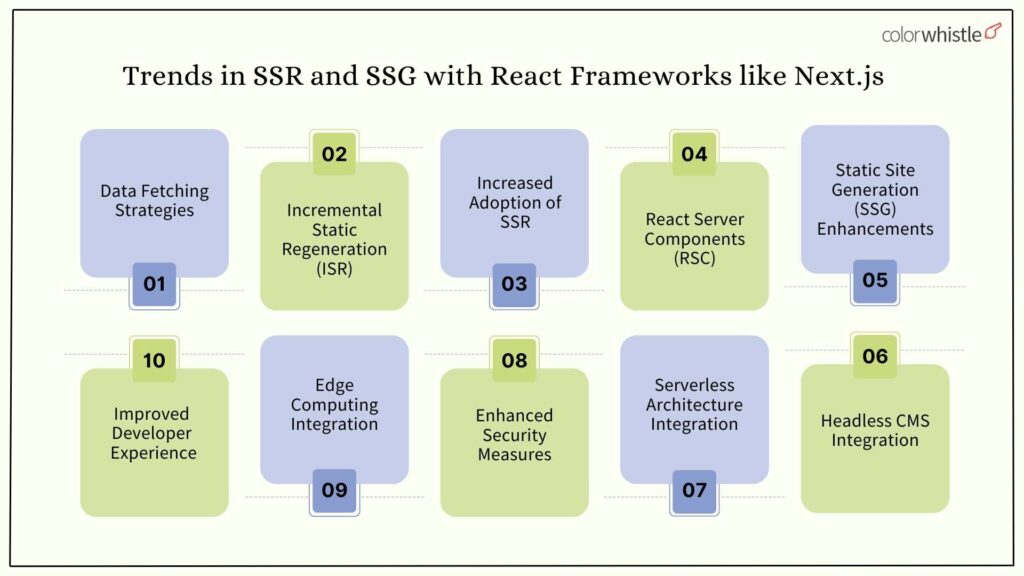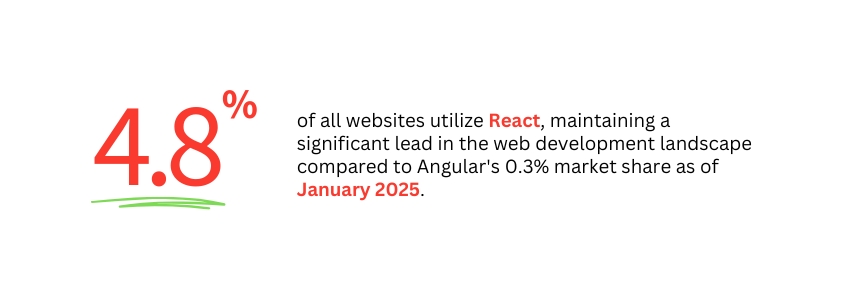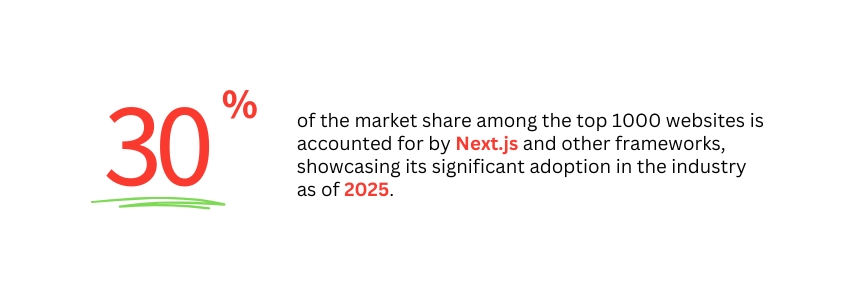Imagine Next.js as a skilled magician on stage, pulling fully rendered web pages out of thin air!
While other frameworks fumble with their tricks, Next.js enchants the audience with swift page loads and SEO-conscious techniques. Server-side rendering serves as the magician’s wand, deftly retrieving content from the server. At the same time, Static Site Generation (SSG) is the pre-arranged rabbit that surprises the audience at just the right moment. With Next.js, each web interaction transforms into a mesmerizing spectacle, leaving users in awe of the seamless experience.
Besides these developments, employing React JS Development Services can elevate your web applications, making them more efficient and engaging for users.
This blog explores the top 10 trends in SSR and SSG with React frameworks like Next.js, unveiling insights that will dazzle you like a magician performing tricks on stage, leaving you in awe of the magic behind modern web development.
Server-side rendering (SSR) & Static Site Generation (SSG)
Server-side rendering (SSR)
Server-side rendering (SSR) is the process by which an application converts HTML files on the server into a fully rendered HTML page for the client. When a web browser requests the server, it receives a fully rendered page in response without delay. This technique allows search engines to crawl and index the content before its delivery, which is beneficial for enhancing Search Engine Optimization.
Static Site Generation (SSG)
Static Site Generation (SSG) refers to a technique for constructing websites in which HTML pages are produced from templates and content sources during the build process, rather than being generated in real-time. This approach yields static websites composed of pre-rendered HTML, CSS, and JavaScript files. SSGs improve performance, security, and scalability by removing the necessity for server-side processing and database interactions. Notable tools for SSG include Jekyll, Hugo, and Gatsby, which facilitate the development of content-oriented sites such as blogs and documentation.
Key Trends in SSR and SSG

1. Data Fetching Strategies
- Data fetching strategies are essential for optimizing applications in React frameworks, particularly Next.js.
- Static Site Generation (SSG) pre-renders pages at build time, making it ideal for static content and improving performance and SEO.
- Server-side rendering (SSR) generates HTML for each request, making it suitable for dynamic data that needs real-time updates.
- Incremental Static Regeneration (ISR) merges SSG and SSR, allowing for updates to static pages without requiring a full rebuild.
- Client-side rendering (CSR) fetches data post-initial render, which is most effective for non-essential data.
- These strategies empower developers to customize user experiences according to specific data needs and performance criteria.
2. Incremental Static Regeneration (ISR)
- Incremental Static Regeneration (ISR) is a feature of Next.js that facilitates the updating of static content without the need for a full site rebuild.
- ISR merges the advantages of static site generation (SSG) with the adaptability of server-side rendering (SSR).
- Pages can be regenerated on-demand in response to incoming traffic, enhancing user experience.
- This feature is especially beneficial for websites with frequently changing data, such as news platforms and product catalogs.
- ISR ensures that users access the most up-to-date information while benefiting from fast loading times.
3. Increased Adoption of SSR
- Server-side rendering (SSR) optimizes website performance and enhances search engine optimization (SEO).
- SSR enhances user experience by reducing page load times, crucial for maintaining high search engine rankings.
- Frameworks such as Next.js simplify the implementation of SSR for developers.
- There is a notable trend towards building more responsive and SEO-friendly web applications, particularly for content-rich and eCommerce sites.
- The adoption of SSR reflects a broader shift in web development practices aimed at improving site efficiency and visibility.
4. React Server Components (RSC)
- React Server Components (RSC) revolutionize server-side rendering (SSR) in React applications.
- They enable server-side rendering of components while maintaining interactivity, enhancing user experience.
- RSC significantly reduces the volume of JavaScript transmitted to the client, leading to quicker load times.
- The implementation of RSC is expected to enhance the overall performance of web applications.
- As RSC gains traction among developers, there will likely be a trend towards creating more dynamic and responsive applications that utilize server capabilities efficiently.
Did You Know?
By supporting server-side rendering (SSR) and static site generation (SSG), the Next.js framework enhances the visibility of websites in search engines and improves the indexing of content, a crucial factor for attracting organic traffic.
5. Static Site Generation (SSG) Enhancements
- Static Site Generation (SSG) is advancing with the introduction of Incremental Static Regeneration (ISR).
- ISR enables developers to update static content without requiring a complete site rebuild.
- Next.js introduces incremental static regeneration, allowing for automatic updates of static content while maintaining optimal site speed.
- This hybrid model merges the advantages of both static and dynamic content, providing versatility for various web applications.
- The evolution of SSG tools includes the integration of advanced features like serverless architectures and refined deployment workflows, enhancing their appeal for contemporary web development.
6. Headless CMS Integration
- Headless CMS integration is becoming a crucial trend in server-side rendering (SSR) and static site generation (SSG) with React frameworks, particularly Next.js, in 2025.
- This approach separates front-end presentation from back-end content management, facilitating efficient content delivery across various platforms.
- Businesses are gravitating towards headless CMS due to its flexibility, which allows for quick adaptation to emerging digital touchpoints.
- The integration of headless CMS supports omnichannel delivery, significantly improving user experience and engagement.
- Seamless content distribution across websites, mobile applications, and social media is a key benefit, ensuring a consistent brand narrative.
Also Read
7. Serverless Architecture Integration
- The transition to serverless architectures is revolutionizing Server-Side Rendering (SSR) in web applications.
- This model eliminates the need for direct server management, streamlining the development process.
- Operational costs are significantly reduced, making it a cost-effective solution for developers.
- Scaling becomes simpler as cloud services automatically manage resource allocation based on demand.
- The synergy between serverless architecture and SSR enhances application performance, particularly during peak traffic.
8. Enhanced Security Measures
- Security is paramount in web development, especially for applications utilizing Server-Side Rendering (SSR).
- Developers prioritize enhancing security protocols to address vulnerabilities like cross-site scripting (XSS) and cross-site request forgery (CSRF).
- Modern SSR frameworks are implementing strategies to minimize the transmission of sensitive data to clients, ensuring that most information remains on the server side.
- This method not only improves performance but also fortifies security measures.
- The trend of maintaining data on the server side is increasingly essential as web applications grow in complexity.
Did You Know?
Prominent brands like Nike and Spotify have integrated Next.js which has significantly enhanced its popularity and affirmed its trustworthiness in actual applications.
9. Edge Computing Integration
- Edge computing is becoming a key trend in server-side rendering (SSR) and static site generation (SSG) with React frameworks like Next.js.
- It processes data closer to users, reducing latency and improving application performance.
- This integration enhances the responsiveness and efficiency of applications.
- Developers can utilize Content Delivery Networks (CDNs) for caching, optimizing the delivery of pre-rendered HTML content.
- Users benefit from faster load times and better SEO, as search engines can easily index fully rendered pages.
- The combination of SSR and edge computing is essential for meeting real-time data demands and personalization in modern web development.
10. Improved Developer Experience
- Evolving frameworks are increasingly focused on enhancing the developer experience in Server-Side Rendering (SSR) and Static Site Generation (SSG).
- Tools that simplify setup processes are gaining importance in frameworks such as Next.js.
- Enhanced debugging capabilities are being integrated into these frameworks to support developers.
- Improved documentation is becoming a standard feature, aiding developers in understanding and utilizing the frameworks effectively.
- Overall, the enhancements contribute to a more productive development environment for developers.
Also Read
The Magic Continues: SSR & SSG in 2025
Ultimately, the trends surrounding Server-Side Rendering (SSR) and Static Site Generation (SSG) in React frameworks such as Next.js are redefining web development. As developers turn to hybrid rendering approaches, they can efficiently serve both dynamic and static content.
The advancements in performance, SEO, and user experience highlight the critical role of these technologies. With continuous improvements, Next.js remains an essential tool for creating fast, responsive applications that fulfill modern expectations.
If you are seeking professional React JS Development Services for your business platform, ColorWhistle offers a luxurious array of digital solutions tailored to meet your needs. Contact us at +1 (919) 234-5140 to start collaborating and achieving your business objectives.
What’s Next?
Now that you’ve had the chance to explore our blog, it’s time to take the next step and see what opportunities await!







